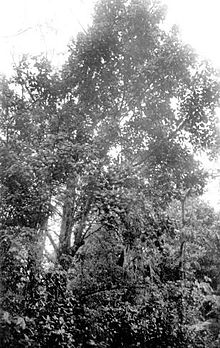| Magnolia portoricensis | |
|---|---|

| |
| Jagüilla tree (Magnolia portoricensis) next to a trail at Bosque Estatal de Carite, in Puerto Rico. | |
|
Scientific classification
| |
| Kingdom: | Plantae |
| Clade: | Tracheophytes |
| Clade: | Angiosperms |
| Clade: | Magnoliids |
| Order: | Magnoliales |
| Family: | Magnoliaceae |
| Genus: | Magnolia |
| Section: | Magnolia sect. Talauma |
| Subsection: | Magnolia subsect. Cubenses |
| Species: | M. portoricensis
|
| Binomial name | |
| Magnolia portoricensis Bello
| |
Magnolia portoricensis is a tree of the Caribbean region. Its vernacular names include jagüilla [2] and Puerto Rico magnolia. [3] It is native to Puerto Rico and it is found in the Toro Negro State Forest. [4] It is an endangered tree and endemic to Puerto Rico. It is a dicot and a part of the family Magnoliaceae. It is an uncommon tree, found primarily in the central and western mountains at 500 to 925 m above sea level.
Habitat/ecology
Magnolia portoricensis is a fairly large evergreen tree that can grow as tall as 25 m. In Puerto Rico it can be found specifically in state forests of the central region such as Carite, Toro Negro, Guilarte West and Maricao, and in higher elevation areas like Ciales, Jayuya and Adjuntas.. This tree grows in cloud forests with about 2000 to 4000 mm of rainfall per year. It is found mostly on the peaks and slopes of mountains, thriving best in volcanic areas. These soils are derived from igneous rocks (including serpentine), have high clay content, and are moderately well drained, with pH between 5 and 7.5. Abundant moisture in the soil is typical and may be essential for the development of the jaguilla.
Key features
Leaves are large, oval shaped, and waxy, and are alternate on the stem. Leaves and stems are free of hairs, distinguishing it from the closely related Magnolia splendens that grows in the eastern mountains. The Jaguilla produces white flowers that are large, fragrant and showy. The flowers are hermaphroditic. The numerous carpels each have a curved style that peaks in the center; each carpel is pale yellow and about 6 mm to 12 mm long. There are numerous stamens surrounding the carpels; they are each about 13 mm long.
After pollination (perhaps by beetles as in other Magnolia species) the fruit that it produces is conical in shape and greenish, measuring about 3.5 cm long and 2.5 cm wide. The fruits crack open when ripe, revealing triangular seeds with fleshy orange arils that aid in their dispersal by birds. Rodents are seed predators. Inside the seeds, there is an oil in the endosperm that surrounds the embryo that is found in about 50% of all magnolias. Seedlings are shade tolerant and the tree is slow growing. Association of the roots with arbuscular mycorrhizal fungi is essential for growth.
Plant uses
The jaguilla has high wood quality so it is used for furniture and lumber. Previously it had been used to shade high-altitude coffee plantations that have since been abandoned. The oil of the Magnolia is an ingredient in soap, lotions and perfumes
Conservation
The species population is currently endangered because of deforestation, and the population continues to decline. Puerto Rico currently has no conservation efforts for the tree. [5] [6] [7] [8] [9] [10]
References
- ^ "IUCN Red List of Threatened Species: Magnolia portoricensis". IUCN Red List of Threatened Species. 30 April 2007.
- ^ Magnolia portoricensis: Bello Jagüilla. USDA Forest Service. Retrieved 8 August 2013.
- ^ USDA, NRCS (n.d.). "Magnolia portoricensis". The PLANTS Database (plants.usda.gov). Greensboro, North Carolina: National Plant Data Team. Retrieved 28 June 2015.
- ^ Bosques de Puerto Rico: Bosque Estatal de Toro Negro. Archived 7 August 2015 at the Wayback Machine Hojas de Nuestro Ambiente. July 2008. [Publication/Issue: P-030] Puerto Rico Department of Natural and Environmental Resources. Retrieved 12 September 2013.
- ^ Alemany-Merly, S. E. 1999. Magnolia portoricensis Bello = Jaguilla: Magnoliaceae: Magnolia family. USDA Forest Serv., Rio Piedras, PR, Inst. Trop. Forestry. 88:1–6.
- ^ Anales de la Sociedad Española de Historia Natural 10: 233. 1880. (Anales Soc. Esp. Hist. Nat.)
- ^ Anonymous. 1986. List-Based Rec., Soil Conserv. Serv., U.S.D.A. Database of the U.S.D.A., Beltsville.
- ^ Bello. 1880. In: Anales Soc. Esp. Hist. Nat. 10: 233
- ^ Govaerts R. (ed). For a full list of reviewers see: http://apps.kew.org/wcsp/compilersReviewers.do (2013). WCSP: World Checklist of Selected Plant Families (version Oct 2011). In: Species 2000 & ITIS Catalogue of Life, 11 March 2013 (Roskov Y., Kunze T., Paglinawan L., Orrell T., Nicolson D., Culham A., Bailly N., Kirk P., Bourgoin T., Baillargeon G., Hernandez F., De Wever A., eds). Digital resource at www.catalogueoflife.org/col/. Species 2000: Reading, UK.
- ^ Salvador E, Alemañy-Merly. "Magnolia Portoricensis Bello Jagüilla." Web. 13 Dec. 2014. < http://www.fs.fed.us/global/iitf/Magnoliaportoricensis.pdf>.
